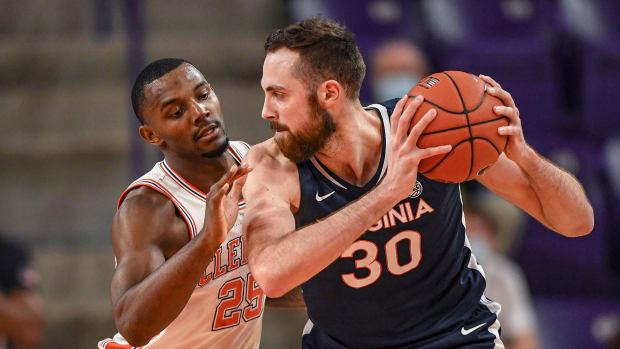The conference only has two teams in the top 25, but it will still populate a good percentage of the Big Dance bracket.
We're halfway through the 2020–21 college basketball regular season, and conference play is well underway across the country. As teams jockey for position both in their own league standings and for NCAA tournament seeding, Sports Illustrated is checking in on the seven major conferences in men's college hoops (American, ACC, Big 12, Big East, Big Ten, Pac-12 and SEC) this week to see where each stands and how it has shaped up compared with preseason expectations.
We've already done the American, Big East and Big 12; next is the ACC.
State of the conference
It’s different. And definitely not dominant. There is no ACC team in the latest AP top 10, and just two are ranked at all (Virginia and Clemson), an indication that the league is underperforming so far in this chaotic season. Specifically, Tobacco Road is not pulling its load—Duke and North Carolina are both outside the top 25 at the same time for the first time since December 1982. (The blueblood malaise is everywhere; Kentucky has a losing record and Kansas is three games behind Baylor in the Big 12.) However, this should not be viewed as a shocking development: The Blue Devils came into the season ranked ninth and the Tar Heels 16th; nobody was expecting banner seasons from those two. Given the most recent results in the league, Virginia and Florida State might be prepared to separate themselves from a sprawling pack.

Biggest surprise: Virginia Tech
Virginia Tech is 11–2 overall, 5–1 in the league, with wins over Villanova, Clemson and Duke. Just about everyone would give second-year coach Mike Young the Coach of the Year award at this point. The Hokies were picked to finish 11th by the media in the preseason, coming off a 16–16 year when they lost 11 of their last 13 games. But Young retooled the lineup with a couple of transfers added to the frontcourt in 6' 9", 235-pound Keve Aluma (from Wofford, Young’s prior stop) and 6' 7", 230-pound Justyn Mutts (Delaware). Last year, Tech was 347th nationally in free throw rate; this year it is 70th. “His team has gotten a lot better since last year,” says Wake Forest coach Steve Forbes, noting particularly the increased muscle in the lineup. “He’s getting guys on the team that care about winning and not about themselves.”
Biggest disappointment: Syracuse
Syracuse was picked to finish sixth preseason but currently is in 10th place at 2–3 in the league, 7–4 overall. Currently, the Orange is 1–4 against teams in the Ken Pomeroy top 90. And here’s the bad news: Every remaining opponent but one is ranked in the top 90. A team that was supposed to be built around its three-point shooters is making just 32.2% from outside the arc, and nobody is struggling more from deep than coach’s son Buddy Boeheim (29.4%, including a 0-for-8 game against Pittsburgh on Saturday). Syracuse hasn’t been a national contender since 2014, which was also the last time the Orange were seeded higher than 8th in the NCAA tournament. The program seems like it is fading into obsolescence in Jim Boeheim’s coaching twilight.
The current favorite: Virginia
Virginia put on one of the most dominant performances of the season Saturday, mauling a very respectable Clemson team 85–50 and running its record to 5–0 in the league. “Virginia could have beaten Gonzaga Saturday,” says Georgia Tech coach Josh Pastner. Shooting 15 for 27 from three and 19 for 29 from two isn’t going to happen every game—but given the way the Cavaliers guard, it doesn’t have to. Senior 7-footer Jay Huff is playing the best ball of his career, junior Kihei Clark is the heady point guard Tony Bennett always seems to have and Marquette transfer Sam Hauser is the offensive difference-maker Bennett needed.
MORE: How Top ACC Contenders Stack Up Nationally
The top challenger: Florida State
FSU (8–2, 4–1) is the team best equipped to challenge Virginia. Since losing at Clemson on Dec. 29, the Seminoles have dispatched North Carolina State, North Carolina and Louisville with ease. Leonard Hamilton has a deep veteran cast led by M.J. Walker (14.9 points per game), but also a touch of phenom star power in 6' 9" freshman point guard Scottie Barnes (11 points, four rebounds, team highs of 3.7 assists and 1.6 steals). If Barnes raises his game down the stretch, the Seminoles could go a long way. Circle Feb. 15 on the calendar; that’s when Virginia will come to Tallahassee.
Dark horse: Clemson
As bad as Clemson looked Saturday against Virginia, the Tigers (9–2, 3–2) are still a quality team with a strong résumé up to this point—they’ve beaten Purdue, Maryland, Alabama and Florida State. They rank ahead of Virginia in defensive efficiency, per Pomeroy, which can help overcome some occasionally fickle shooting. The last half of the league schedule sets up very well: six home games and three on the road, and the games away from Clemson are all winnable (Notre Dame, Pittsburgh, Wake Forest).
NCAA tournament outlook
In 2021, the ACC has ceded conference supremacy to the Big Ten—but this league still will populate a good percentage of the Big Dance bracket. How far they go will be the question. Virginia is trending into a top-16 seed and could move up into contention for a No. 1 seed before all is said and done. Florida State could earn a high seed as well. After that, expect the ACC to occupy a lot of middle ground in the seedings. How many advance to the Sweet 16 and beyond will probably be the measuring stick for how much of a down year this is in a league that has put five teams in the last five Final Fours.